‘Flying fishermen’: the key features that help ospreys hunt
You don’t gain the nickname ‘flying fisherman’ without being up for the job.
Ospreys have a number of features which help them succeed as an apex predator. Here are some of the adaptations they have which allow them to fish with the great success.
Ospreys long muscular legs assist during hunting, by enabling them to stretch below the water’s surface to grab the fish spotted from some 30 metres above. The strength in their leg muscles is also used to hold the fighting fish still and suspend it mid-air in a head-first aerodynamic position, until arriving at a perch to dine peacefully.
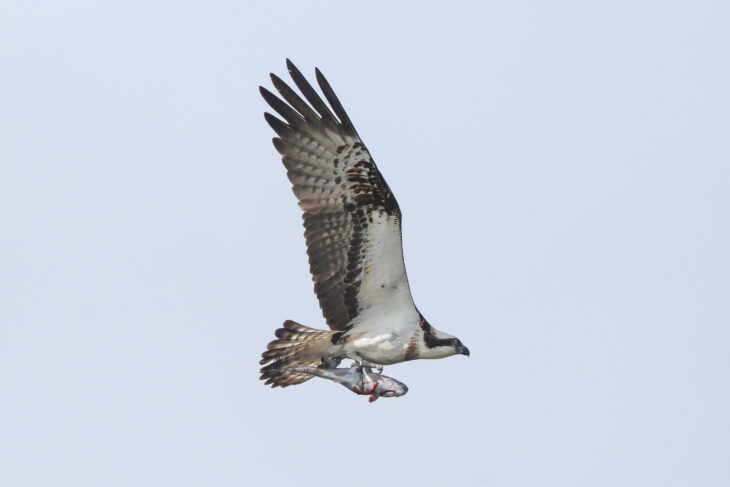
Blue YD clutching a fish © Ron Mitchell
The dive itself requires absolute accuracy, first in spotting a fish and then falling to meet its exact location to catch it. Amazingly keen eyesight and wing maneuverability are needed to guarantee a grip on its prey. The osprey’s sharp and curved talons pierce the unsuspecting fish, while the gripppy, ridged skin on the underside of their feet, called ‘spicules’ prevent the fish from slipping away.
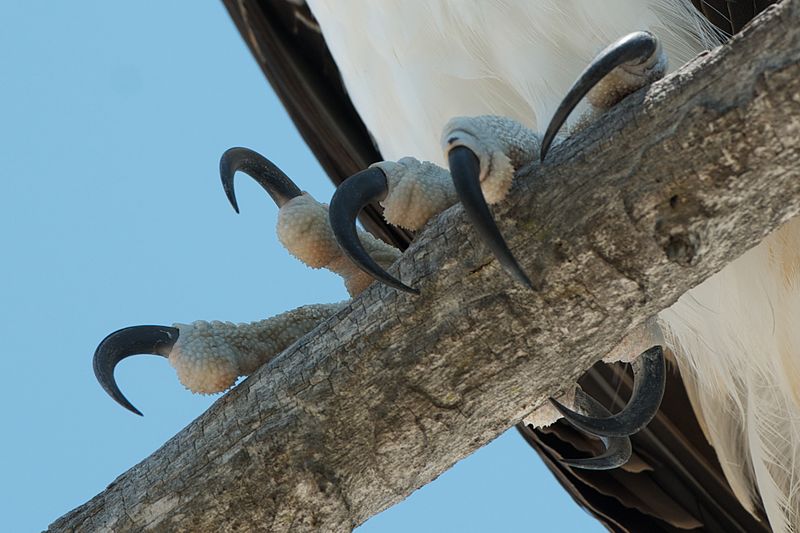
A powerful impact is ensured by extending legs just before contact with the water’s surface. Once the fish has been pierced the grip is secured further with the use of reversible or ‘zygodactyl’ outer toes, which swing round to join the rear toe on each foot . These paired toes give greater control in grasping and maintaining hold on the prey and is an adaptation also found in owls and woodpeckers.
When ospreys preen a protective oil from the uropygial gland located near the base of their tail is spread over their feathers.
Now for the hard bit. How do you get back out of the water with a 5lb fish in tow and wet feathers?
Having feathers that don’t get wet is a big help in this situation. When ospreys preen, a protective oil from the uropygial gland located near the base of their tail is spread over their feathers – giving them a waterproof coating. Effectively, there’s no such thing as a bad hair day for ospreys!
A powerful and large wingspan of 1.3m – 1.8m helps them regain altitude, but lifting off when wet and with a heavy fish in tow still demands a lot of effort. An additional adaptation is the ospreys’ iconic ‘M’ shaped wing, as can be seen from their shape in flight. This shape and the ability to pivot backwards from the shoulder joint allows for a broader range of motion and when combined with longer than average primary feathers, assists the ospreys in lifting off from the water with a series of powerful wing beats. This pivoting action is also used as a powerful braking mechanism when coming in to land on the nest.
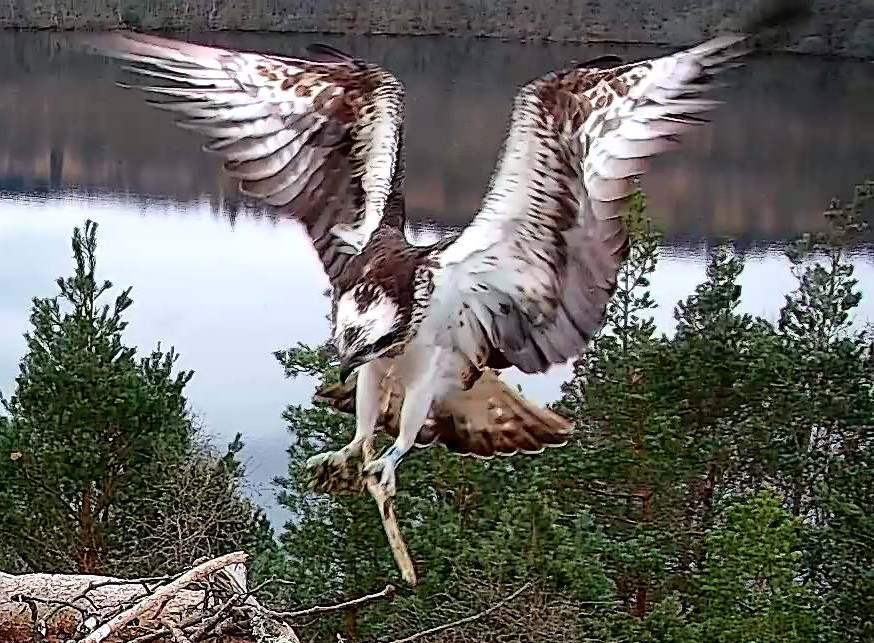
These birds’ feathers aren’t only special for their water repellent quality. Their colour gives them a striking appearance which may stand out to people, but for the osprey, this acts as camouflage throughout their lives. To a larger, rival bird of prey, young ospreys on the nest appear as a brown mottled mass. And as adults, the pale underside of an osprey’s plumage can be advantageous in blending into the bright sky, when scanning for fish over a body of water. It is even thought that the black ‘bandit’ eye mask helps reduce reflections on the water.
Ospreys commonly soar above water to hunt, at heights of up to 40m, and can plummet downwards at a speed of 125km/h. At these altitudes, excellent vision is a must for being able to see a potential catch. A high density of receptors in the eye enables this excellent, clear vision. Their eyes are adapted for a proficiency in hunting fish in another way, as they have a third transparent eyelid, or a nictating membrane which protects the eye upon impact with the water.
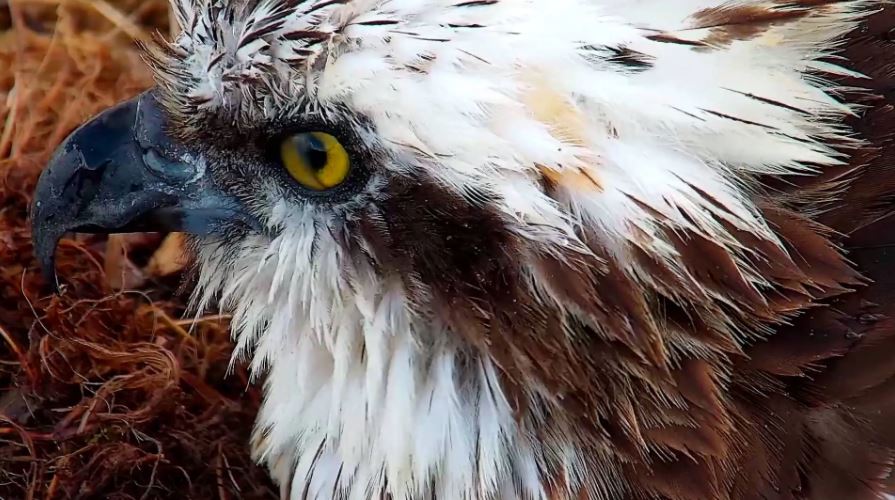
Hunting Success
Ospreys unique adaptions increase their chances of success when hunting, although usually only 1 out of 4 attempts to catch a fish are successful. External factors such as high winds, poor visibility in heavy rain or the size of the fish can also make things more challenging. Although their wings are mostly tucked in when diving for a fish, wind can still catch them and push them slightly off course, causing them to land out of range of their meal. Fish automatically respond to predators by swimming downwards and if an osprey has aimed for a particularly large species such as pike (which can grow up to 1.5m in length), they may be unable to lift it from the water – never mind getting it back to the nest site.
Fishing Statistics
During our Osprey Watch nest protection programme we closely monitor the behaviour of the ospreys at Loch of the Lowes, including the quantity and variety of fish brought to the nest. This can help build up our understanding of any factors that have impacted on the success of the breeding season, including weather, food source and even the influence of intruding birds. An overview of our fish data for April/May can be viewed in the graph below:
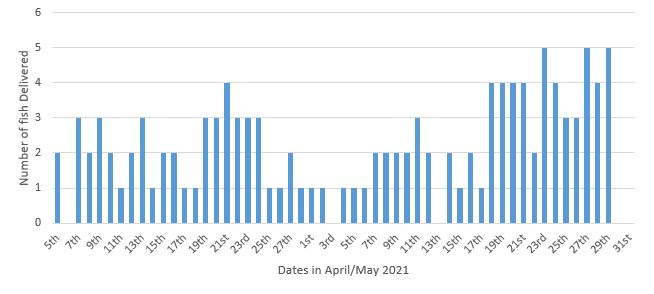
Going into May, LM12 brought in a consistent 1 – 2 fish every day for his impatient partner. However, now the chicks have hatched, these numbers just won’t cut it. With an additional two mouths to feed, the number of fish delivered each day has practically doubled, as anticipated. We knew from the statistics that this would be achievable as for much of April despite challenging weather, we recorded LM12 bringing in 3 fish deliveries per day. This means that weather permitting, we can expect LM12 on a good day to easily bring in 3 or even 4 fish to the nest! As the chicks increase in size and appetite this may increase even further.
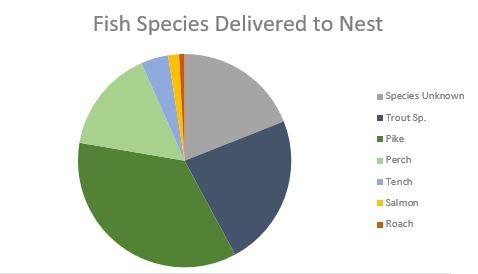
121 fish have been caught so far this season. The pie chart shows this impressive catch broken down into species type. This can be useful in determining where LM12 may be fishing and the extent of his hunting territory. The results so far have shown us that pike are the most popular meal, followed by brown trout and perch. With fish brought to the nest often being headless, our identification skills are often challenged, resulting in a significant number of fish remaining unidentified.
Ospreys are supremely adapted to hunting with maximum efficiency. Even with their physiological advantages there is a high energy demand on their bodies. Being packed full of protein and calories each catch quickly replenishes any lost energy, with the male osprey often taking first dibs on the most nutrient-rich part of the fish – the head.
What were weak wobbly-headed chicks barely 2 weeks ago, are now healthy young osplets beginning to develop their adult osprey features! Thanks to the excellent hunting skills of LM12 and the attentive feeding of NC0 the pair will quickly pile on 70% of their body weight within the first month alone.
Time really does fly! Join us as we watch them grow, and follow the exciting events of NC0 and LM12 navigating parenthood on our live webcam.
Helen Lancaster
Species Protection Officer
Help protect Scotland’s wildlife
Our work to save Scotland’s wildlife is made possible thanks to the generosity of our members and supporters.
Join today from just £3 a month to help protect the species you love.
Preface
You don’t gain the nickname ‘flying fisherman’ without being up for the job. Ospreys have a number of features which help them succeed as an apex predator. Here are some …
